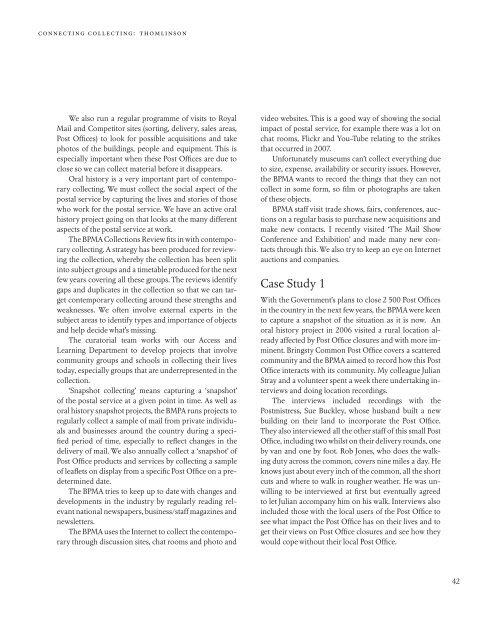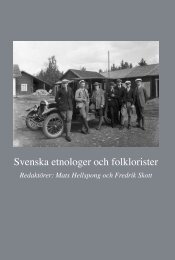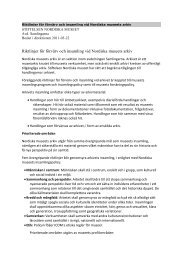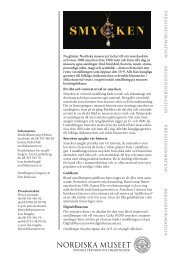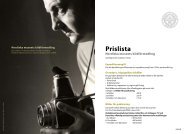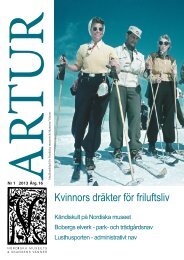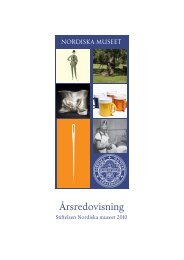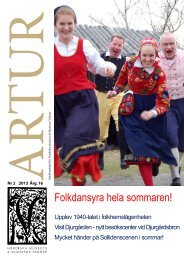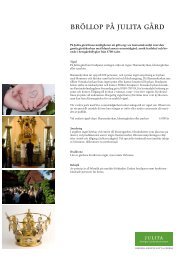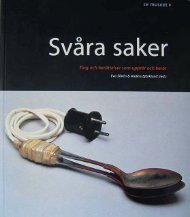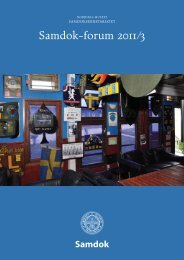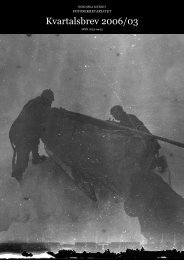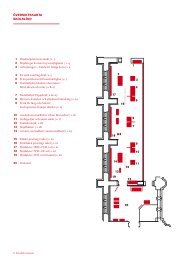Samdok - Nordiska museet
Samdok - Nordiska museet
Samdok - Nordiska museet
You also want an ePaper? Increase the reach of your titles
YUMPU automatically turns print PDFs into web optimized ePapers that Google loves.
connecting collecting: thomlinson<br />
We also run a regular programme of visits to Royal<br />
Mail and Competitor sites (sorting, delivery, sales areas,<br />
Post Offices) to look for possible acquisitions and take<br />
photos of the buildings, people and equipment. This is<br />
especially important when these Post Offices are due to<br />
close so we can collect material before it disappears.<br />
Oral history is a very important part of contemporary<br />
collecting. We must collect the social aspect of the<br />
postal service by capturing the lives and stories of those<br />
who work for the postal service. We have an active oral<br />
history project going on that looks at the many different<br />
aspects of the postal service at work.<br />
The BPMA Collections Review fits in with contemporary<br />
collecting. A strategy has been produced for reviewing<br />
the collection, whereby the collection has been split<br />
into subject groups and a timetable produced for the next<br />
few years covering all these groups. The reviews identify<br />
gaps and duplicates in the collection so that we can target<br />
contemporary collecting around these strengths and<br />
weaknesses. We often involve external experts in the<br />
subject areas to identify types and importance of objects<br />
and help decide what’s missing.<br />
The curatorial team works with our Access and<br />
Learning Department to develop projects that involve<br />
community groups and schools in collecting their lives<br />
today, especially groups that are underrepresented in the<br />
collection.<br />
‘Snapshot collecting’ means capturing a ‘snapshot’<br />
of the postal service at a given point in time. As well as<br />
oral history snapshot projects, the BMPA runs projects to<br />
regularly collect a sample of mail from private individuals<br />
and businesses around the country during a specified<br />
period of time, especially to reflect changes in the<br />
delivery of mail. We also annually collect a ‘snapshot’ of<br />
Post Office products and services by collecting a sample<br />
of leaflets on display from a specific Post Office on a predetermined<br />
date.<br />
The BPMA tries to keep up to date with changes and<br />
developments in the industry by regularly reading relevant<br />
national newspapers, business/staff magazines and<br />
newsletters.<br />
The BPMA uses the Internet to collect the contemporary<br />
through discussion sites, chat rooms and photo and<br />
video websites. This is a good way of showing the social<br />
impact of postal service, for example there was a lot on<br />
chat rooms, Flickr and You-Tube relating to the strikes<br />
that occurred in 2007.<br />
Unfortunately museums can’t collect everything due<br />
to size, expense, availability or security issues. However,<br />
the BPMA wants to record the things that they can not<br />
collect in some form, so film or photographs are taken<br />
of these objects.<br />
BPMA staff visit trade shows, fairs, conferences, auctions<br />
on a regular basis to purchase new acquisitions and<br />
make new contacts. I recently visited ‘The Mail Show<br />
Conference and Exhibition’ and made many new contacts<br />
through this. We also try to keep an eye on Internet<br />
auctions and companies.<br />
Case Study 1<br />
With the Government’s plans to close 2 500 Post Offices<br />
in the country in the next few years, the BPMA were keen<br />
to capture a snapshot of the situation as it is now. An<br />
oral history project in 2006 visited a rural location already<br />
affected by Post Office closures and with more imminent.<br />
Bringsty Common Post Office covers a scattered<br />
community and the BPMA aimed to record how this Post<br />
Office interacts with its community. My colleague Julian<br />
Stray and a volunteer spent a week there undertaking interviews<br />
and doing location recordings.<br />
The interviews included recordings with the<br />
Postmistress, Sue Buckley, whose husband built a new<br />
building on their land to incorporate the Post Office.<br />
They also interviewed all the other staff of this small Post<br />
Office, including two whilst on their delivery rounds, one<br />
by van and one by foot. Rob Jones, who does the walking<br />
duty across the common, covers nine miles a day. He<br />
knows just about every inch of the common, all the short<br />
cuts and where to walk in rougher weather. He was unwilling<br />
to be interviewed at first but eventually agreed<br />
to let Julian accompany him on his walk. Interviews also<br />
included those with the local users of the Post Office to<br />
see what impact the Post Office has on their lives and to<br />
get their views on Post Office closures and see how they<br />
would cope without their local Post Office.<br />
42


